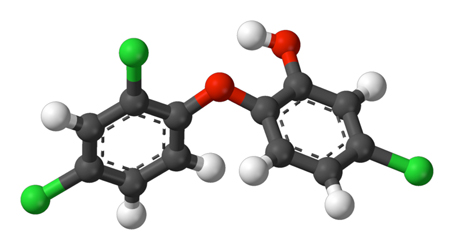I’ve had a number of conversations over the last decade that have gone something like this:
Other person: “I totally agree that overuse of antibiotics and antibacterials is a problem”
Me: “Do you realize how pervasive they are? They’re in toys, laundry detergent, hand soap, cosmetics, deodorants, you name it. In fact, I’ll bet there’s some in your toothpaste.”
Other person: “No way”
Then we go into the bathroom and look… there it is “Active Ingredient: Triclosan”.
*******************************************************************
Triclosan is *everywhere*. It’s an antibacterial and antifungal that is found in thousands of different consumer products. Setting aside the potential direct health impacts of the compound itself (which is a topic of active debate and research), this sort of massive usage is just asking for resistance to develop. Numerous reports on Triclosan resistance have appeared over the years (here’s a good 2006 review on the topic).
The most common concern with antibiotic resistance is the fact that pathogens can become resistant to antibiotics, either directly or through lateral gene transfer. Since Triclosan isn’t used to treat infections, this is less relevant (though of course it will become less and less “useful” over time as organisms become resistant).
The bigger issue with something like Triclosan is that by pumping literally millions of pounds into the environment we are potentially changing natural microbial communities in unpredictable ways. A recent study (sadly not open access) called “Triclosan Exposure Increases Triclosan Resistance and Influences Taxonomic Composition of Benthic Bacterial Communities” looked at this effect in aquatic communities.
Surprise, surprise they found high levels of resistance in natural communities, and that the more Triclosan in the sediment the lower the bacterial diversity of the community. From the abstract:
One notable change was a 6-fold increase in the relative abundance of cyanobacterial sequences and a dramatic die-off of algae within the artificial streams. Selection of cyanobacteria over algae could have significant implications for higher trophic levels within streams.
So basically, we don’t yet know what effect this massive experiment in Triclosan production will have… but my money is on the “not good” end of things.

New at #microBEnet: Overuse of Triclosan impacting natural aquatic communities: I’ve had a number of conversat… http://t.co/sGcaV6LQYN
RT @arturgreensward: Overuse of Triclosan impacting natural aquatic communities: #microBEnet http://t.co/lkEiqsZIyO
RT @Dr_Bik: New at #microBEnet: Overuse of Triclosan impacting natural aquatic communities: I’ve had a number of conversat… http://t.co/s…
New at #microBEnet: Overuse of Triclosan impacting natural aquatic communities: I’ve had a number of conversat… http://t.co/QaYIB6AFHM
Overuse of triclosan is impacting aquatic life by @arturgreensward http://t.co/OkTujCgxiP via @microBEnet
RT @kmkubo: Overuse of triclosan is impacting aquatic life by @arturgreensward http://t.co/OkTujCgxiP via @microBEnet
RT @Dr_Bik: New at #microBEnet: Overuse of Triclosan impacting natural aquatic communities: I’ve had a number of conversat… http://t.co/s…